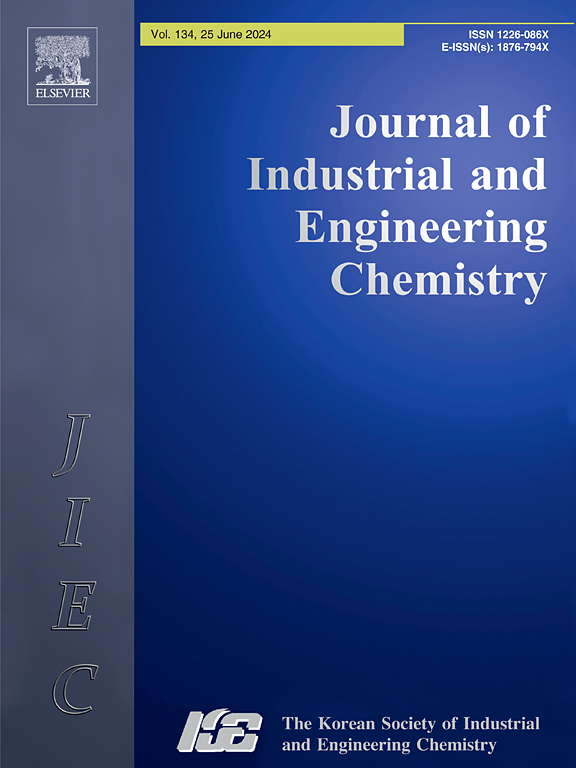Utilizing RSM-CCD for optimizing the removal of Cr(VI) and tetracycline over a new recyclable Fe3O4/SiO2/ZIF-67 composite: Isotherms, kinetics, and mechanism
IF 5.9
3区 工程技术
Q1 CHEMISTRY, MULTIDISCIPLINARY
Journal of Industrial and Engineering Chemistry
Pub Date : 2024-10-30
DOI:10.1016/j.jiec.2024.10.052
引用次数: 0
Abstract
Pollution of water resources by a range of organic and inorganic non-degradable contaminants is becoming increasingly problematic. This study presents a novel Fe3O4/SiO2/ZIF-67 (FSZ) nanocomposite for removing tetracycline (TC) and hexavalent chromium (Cr6+). The synthesis began with the preparation of Fe3O4, SiO2, and ZIF-67 components. Following this, various loadings of the binary SiO2/ZIF-67 were prepared. Finally, the ternary FSZ adsorbents were synthesized by impregnating 1, 3, 5, 7, and 9 wt% of Fe3O4 nanoparticles (NPs) onto the optimized binary SiO2/ZIF-67 NPs. Characterization techniques such as SEM, TEM, BET, EDS, XRD, and XPS were performed. The removal efficiencies were optimized using the RSM-CCD, considering factors like composite dosage, reaction time, pH levels, and contaminants concentration. Optimal composite dosages of 0.69 g/L for TC and 1.68 g/L for Cr6+, pH values of 6.05 for TC and 6.06 for Cr6+, reaction times of 90 min for TC and 57 min for Cr6+, and contaminant concentrations of 25.47 mg/L for TC and 2683.2 ppb for Cr6+ were achieved. Removal rates of 98.53 % for TC and 97.45 % for Cr6+ were achieved under optimal conditions. Moreover, various kinetic and isothermal adsorption models were applied. The FSZ composite maintained high removal efficiencies for Cr6+ (81.14 %) and TC (79.82 %) after four cycles. Its performance was assessed in various water types, including deionized water, river water, and municipal wastewater. Additionally, the FSZ composite effectively removed other contaminants, achieving high efficiencies for cadmium (95.18 %), lithium (83.42 %), arsenic (88.29 %), sulfamethoxazole (87.38 %), doxycycline (96.15 %), and cefixime (81.97 %). Finally, the mechanisms responsible for the removal of TC and Cr6+ were evaluated. The sustainable synthesis of FSZ provides a valuable foundation for future studies focused on Cr6+ and TC removal, offering a potential solution to pressing environmental challenges.

求助全文
约1分钟内获得全文
求助全文
来源期刊
CiteScore
10.40
自引率
6.60%
发文量
639
审稿时长
29 days
期刊介绍:
Journal of Industrial and Engineering Chemistry is published monthly in English by the Korean Society of Industrial and Engineering Chemistry. JIEC brings together multidisciplinary interests in one journal and is to disseminate information on all aspects of research and development in industrial and engineering chemistry. Contributions in the form of research articles, short communications, notes and reviews are considered for publication. The editors welcome original contributions that have not been and are not to be published elsewhere. Instruction to authors and a manuscript submissions form are printed at the end of each issue. Bulk reprints of individual articles can be ordered. This publication is partially supported by Korea Research Foundation and the Korean Federation of Science and Technology Societies.

 求助内容:
求助内容: 应助结果提醒方式:
应助结果提醒方式:


